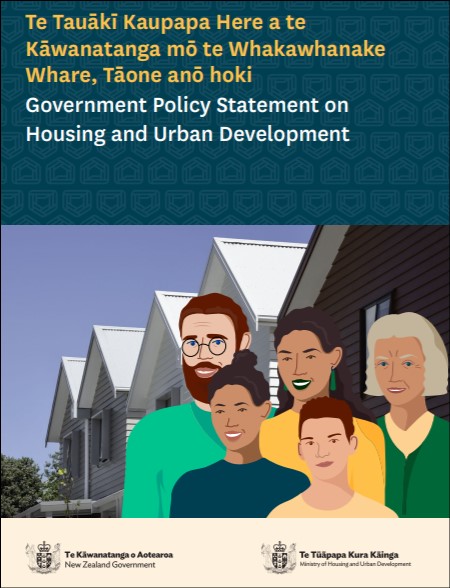Government policy statement on housing and urban development
Author:
Ministry of Housing and Urban DevelopmentSource:
New Zealand GovernmentPublication date:
2021Topics:
HousingTe Tauākī Kaupapa Here a te Kāwanatanga mō te Whakawhanake Whare, Tāone anō hoki
Extract:
Why we need a GPS‑HUD
The housing and urban development challenges facing Aotearoa New Zealand are complex and systemic. The poor housing and urban outcomes we are experiencing have developed across decades and require a concerted and aligned effort to resolve.
Aotearoa New Zealand households spend the largest proportion of their disposable income on housing costs in the OECD. According to The Better Life Index 2020, our households spend on average 26% of their gross adjusted disposable income on housing, compared to the OECD average of 20%. Our unaffordable housing is resulting in too many people in housing stress or experiencing homelessness. In addition, the homes we do have often are not meeting our needs.
Significant global and local challenges will continue to impact how and where we live.
COVID-19 has exacerbated the housing and urban inequality that exists in Aotearoa New Zealand. Whilst the full extent of the wellbeing and economic impacts of COVID-19 are yet to be seen, we need to position ourselves to succeed in an uncertain future which includes addressing the long-term systemic barriers that have constrained housing and urban development in this country.
Our climate is changing. Many buildings, homes and places in Aotearoa New Zealand are already at risk from natural hazards and we can expect these risks to grow in frequency and severity due to the changing climate. Sea level rise will threaten our coastal communities and raise groundwater. Extreme weather events will be stronger and increase the risk of flooding, erosion and landslides. Higher temperatures may cause heat stress, lead to increasingly dangerous forest and bush fires, and prolong and worsen droughts. These changes will impact infrastructure as well as the physical and social wellbeing of communities.
At a local scale our population is growing and changing. By 2048 our population will exceed 6.2 million people. Much of this population growth is projected to be in the larger urban areas, particularly in Auckland, where the population will increase by almost 650,000 more people. Our population is also aging and diversifying which will have additional impacts on how and where we live. Within thirteen years it is estimated that one quarter of our population will be aged 65 or over. This shift in demographics will place additional pressures on our homes and places to be adaptable and accessible. Family and household structures are expected to continue to diversify requiring an increasing variety of different housing options in places.
The GPS-HUD helps set direction
The Government Policy Statement on Housing and Urban Development (GPS‑HUD) presents a multi-decade system strategy for housing and urban development. It will inform, influence and align activity across the system to respond to the challenges we face.
For government, the GPS‑HUD acts as an anchor from which aligned and consistent decisions can be made. The Government expects all agencies to help implement the GPS‑HUD, and to consider how they can shift and align their policy and investment to support it, while also delivering on their core roles. ...
September 2021
